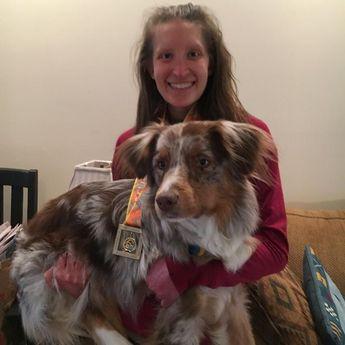Eager to lace up your shoes and hit the trails with a furry friend? Look no further. Click the Dog Race Finder below to search the largest, most comprehensive database and find a dog-friendly walk or run near you!
*If you would like to add a dog-friendly walk/run to the database, or would like any changes/updates made to your event, email Sadi at sadi@runrepeat.com.
Dog Friendly Events Reshaping America: The Research
Did you see a dog at the last walk or run you attended? Odds are if you live in California or Texas you are likely to jog alongside a furry friend this year. Which state hosts the most dog races? Can you run a color run or a warrior dash with your dog? You asked, we researched, and the results are barking mad!
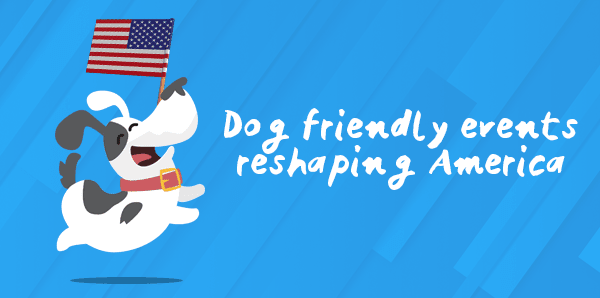
What Our Paper Found
A summary of the fantastic, furry, fun insights you will gain reading this paper!
- Research supports a connection between dog ownership, physical activity and health. ( 1 )
- While not well documented, thousands of dog-friendly walk/run events exist.( 2 )
- Dog friendly-events are increasingly in the public eye. ( 3 )
- National organizations are using dog-friendly walks/runs to promote health and wellness. ( 4 )
- Risks and liabilities related to canine participation in events can be surmounted. ( 5 )
- Passionate race directors include dogs for many different reasons. ( 6 )
- Dog-friendly events have awesome SWAG and perks! ( 7 )
- A range of new dog-friendly events (e.g., color runs, mud runs, warrior dashes) are now available. ( 8 )
- The majority of dog walk/run events have recently emerged, but some have existed for decades. ( 9 )
- Most dog-friendly events occur during the spring and fall. ( 10 )
- Participation rates vary by year. ( 11 )
- The average size of dog-friendly events can range widely. ( 12 )
- Most events are a walk/run, with a small number of trail runs or other events (e.g., CaniXC or mud runs). ( 13 )
- Most of the events are not specifically geared toward dogs, but allow them to participate. ( 14 )
- A small but growing number of events chip time dogs and post their results. ( 15 )
- Races are fairly well distributed across the US. ( 16 )
- The number of races is most closely tied to the size of the state’s population. ( 17 )
Bottom Line: You should hop on the trend and check out a dog-friendly walk/run near you!
Introduction: A Connection Between Health and Dogs (1/2)
2018 is the year of the dog, and thousands across the US will celebrate by hitting the trails and pavement with their furry friend. Dating back to the 1960’s, dog participation in active events has taken a sharp spike in recent years. While a mere 20 years ago only a handful of dog-friendly walks/runs existed, today there are over 1,830 where you can walk, run, climb through obstacle courses, go for a color run, and even have your dog pull you to the finish (CaniXC, Skijoring, Bikejor, and even Scooter-jor!).
So what is the drive behind this trend? Americans have loved their dogs for many a decade, but the recent inclusion of dogs in more and more events seems to be tied to the health benefits they bring. A paper published in Scientific Reports in 2017 which studied more than 3.4 million people found that dog owners not only had a lower risk of death due to cardiovascular disease, but also a lower risk of death from any other cause – when compared with those who did not own a dog (1). This held true even after adjusting for other factors such as BMI, smoking and socioeconomic status (SES) (1).
What could be the cause for greater longevity of dog owners? Many research papers point to the link between physical activity and dog ownership. A review of published studies comparing dog owners and non-dog owners on their level of physical activity found that dog owners engage in more physical activity than non-dog owners (2).
These findings have been replicated in a number of other publications, ranging from a study of physical activity in post-menopausal women (4), and comparisons of dog walking and physical activity levels in US and Australia (5), to studies examining the motivations behind dog walking and physical activity (6).

What is it about owning a dog that gets a person to exercise more? Researchers point to the strength of the dog-ownership relationship (6) which breeds a sense of obligation to walk the dog, as well as the fulfillment of other needs such as human social interactions (3).
The authors of the research across the board suggest that health promotion efforts should focus on the benefits of regularly walking for both dog and non-dog owners (4), and their findings strongly support the conclusion that dog walking, or activity with a dog, has a strong potential to increase daily levels of physical activity (5).
If this is the case, it is possible that the rise in more dog-friendly events, such as walks, runs and obstacle courses, may provide an incentive for dog owners to become even more physically active, or inspire others to become dog owners, thus increasing their own health benefits as well.
No dog? No problem! Even for those without canine companions, many animal shelters hold walk/run events where dog-less humans can borrow a furry friend to participate in the event with, and eventually adopt and take home if they decide to do so.
Part I – Dogged Research
Methodology
To further investigate this trend, we commenced a half-year long research study to document, explore and analyze the world of dog-friendly active events. Data collection for this research presented quite a challenge due to the paucity of existing data on the topic.
While many different dog resource databases existed, there was no one comprehensive source covering all of the states in depth. However, for the sake of getting a better picture of running in the USA alone, and in much more depth, it was necessary to consult as many different sources as possible. For full details on data collection, criteria and process, see the Appendix at the end of this paper.
With the data we were able to gather, several general trends emerged which will be discussed in this paper, and hopefully be expounded upon by further research. For the sake of this paper, and to limit the scope, we have focused solely on races in the USA, although there are many dog-friendly walk/run events across the world.
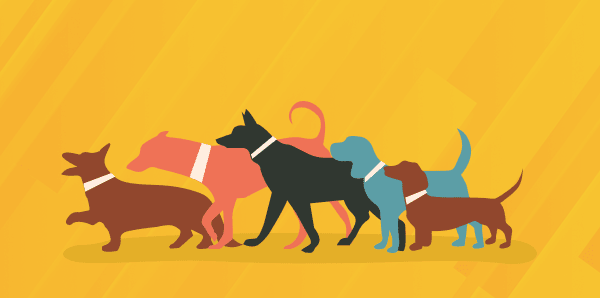
Years Held (9)
While it was not possible to confirm, either through online records of results, information on webpages, or direct contact with race directors, the number of years each event had been held (either because the race director could not be reached, records were not kept, or for other reasons), we were able to obtain data for years run from the vast majority of the dog events. This data is complicated in that some of the races have existed for years, yet only recently become dog friendly – or publicly adopted a dog friendly policy.
Many directors also noted that while they did not officially offer their race as dog-friendly, people have been bringing dogs for years. For that reason, years in existence was calculated as the number of years races which are currently dog friendly have existed, unless it was specifically noted on their site that the race had only allowed dogs for the past X number of years, in which case that number was used.
Upon analysis, overall data trends point to significant longevity of a select number of these events, with most emerging in more recent years. On average, most dog friendly races have existed for 6.89 years (SD =8.23), with a median of three and a mode of one. However, these numbers are more reflective of the fact that a large number of races have sprung up in recent years, and some have existed for very long periods of time.
This is why the standard deviation is so high. If you take a look at the graph in Figure 1, you will see that the majority of races have debuted rather recently, supporting the idea that the number of dog-friendly events has been growing in recent years. However, there are a few that have been around for 20, 30 and even 40+ years.

Figure 1. # of Years Dog-Friendly Events Have Existed (10)
Some of the longest include the Dr. Skip Jackson Dog Jog 5k Fun Run or Walk (46 years), The Animal Humane Society Walk for Animals (44 years), Walk & Wag and Run of the Huron Valley Humane Society (38 years), the Azle Lake Run (37 years), and the Humane Society for Southwest Washington’s Walk/Run for the Animals (27 years). Some of the newer ones include USI’s Doggie Dash and the Wag Walk Run for Kenway’s Cause which premiered in 2017, the Color Me Mutt color run for dogs and their people which began in 2016, and the Chase Your Tail 5k which is going into its fourth year.
While held year-round, most of the dog races seem to occur in early spring and fall, with October being the busiest month with over 16% of races held during this time. On the opposite end, less than 3% of all dog-friendly events occur in the month of January. This is most likely due to considerations for the health and safety of dogs. Some directors reported excluding dogs from races when the weather was too hot, and recommended proper gear (e.g., snow shoes) for dogs racing on trails in colder weather. Humans also tend to favor running in more temperate weather as well!
Are Numbers Rising? (11)
Due to the fact that very few race directors currently keep count of the number of dogs attending their events, it is hard to gauge if the number of dogs attending has risen. While most directors have reported a rise in numbers of humans attending over the years, data on dogs was much harder to find. However, a few races were found which had kept a limited count of dog-participation.
For example, The Chase Your Tail Run reported an increase in dogs from 2016 (159) to 2017 (230), as a result of having the dogs register separately (which was not done in years past). The Fast and the Furry 8k & 5K9 race was one of the few races that kept strict records of their races, which showed an increase in participation over time, with a slight dovetail in recent years, most likely due to increased competition from other events (see Figure 2, complements of The Fast and Furry 8k & 5K9).
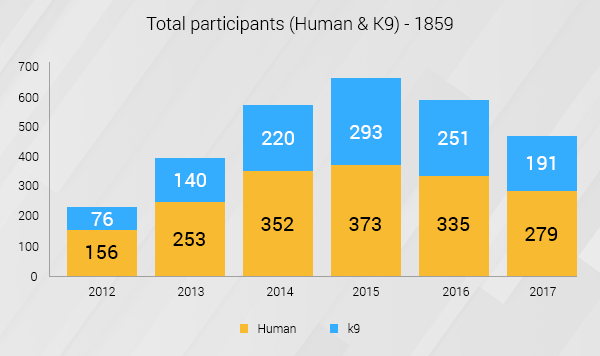
Figure 2. Participation in the Fast and Furry 8K & 5K9 – Harriet Island, St. Paul
Other events such as Strutt With Your Mutt in Kansas City (Brookside) reported a steady increase in participants over time (e.g., 2013 – 890, 2017 – 1086), but did not have documentation of how many people brought a dog. Overall, many race directors noted that they could not give accurate numbers because of the fact that many races allow more than one dog-per person, which could also throw off the dog-human ratio which they calculated.
How Big Are the Races? (12)
Of runs/walks which were labeled as dog friendly and allowed dog participants, the average number of human finishers was 912.23 (SD = 2357.91), with a range from 5 (We are Free 5k), to the Cap City 10K which had over 21,300 registered participants in 2017 (however, not all of these runners chose to run with their dogs).
The median number of attenders was 250, and the mode was 1,000, most likely due to the presence of several cross-country events which draw large numbers of people each year. As a result of the presence of these events, and several mega races which have skewed the data (and thus resulted in a huge SD), the average number of participants may be closer to the median of 250.
Of runs/walks where dog data was either reported or sent to the researcher by the race directors (n = 33), the mean number of dogs in attendance was 337.53 (SD = 691.80), with a median number of 107, and a mode of 250. The Michigan Humane Society, which has put on the Mega March (8 years old) and the Mutt March (30 years old) reports seeing a 1 to 3 dog to human ratio over the years, with 750 dogs and 2250 humans in the last few years on average (for both events combined).
Why such a large range for human and dog participants? Most likely because while some select races/walks are billed as exclusively dog events and draw huge crowds, many others are small-town fundraisers for humane societies and other pet rescue groups where attendance tends to be much lower.
Further, this data was only available from a limited number of race directors who kept track of both dog and human racers, and thus may be skewed toward larger, well organized events, with the capacity and time to document the numbers.
Race Type (13/14)
Of the races/walks which reported being dog friendly, 94.66% were either a walk or a run. 3.5% were trail runs and 1.37% were labeled as CaniCross, with the remaining 0.48% representing other types of events, such as Skijoring, Bikejoring, Mud Runs and Training/Obstacle Course Racing. See Figure 3 for a breakdown by region.
In terms of the classification of the race, 40.27% of the races included were not specifically for dogs, but would allow them to participate. 29.52% were specifically geared toward dogs, and 29.93% were events in which the dog could only participate in the walk portion of the race weekend, or the event was a walk only (e.g., not a walk or run) event.
Approximately 0.27% of all events were virtual runs, however, this does not include the Day of the Dog Race put on by Moon Joggers as this race is available across the US, and is not put on by an organization at one specific state location.

Figure 3. Dog Friendly Events by Type of Event
Chip Timing for Dogs (15)
Another interesting, albeit small trend, was the number of races which offered chip timing for dogs. Overall, across the U.S., there are currently 20 races which offer chip timing exclusively for your dog (e.g., not giving you and your dog the same time as your chip), and many of those offering post the results online along with the human results (e.g., Jog with Your Dog 5k).
Many dog-oriented races which do not chip time dogs nonetheless still use other methods of standardized timing and either post these results, or the humans time online under the dog’s name, and others reported a desire or intention to begin chip timing with next year’s race.
Race of the Regions: Is it a Cultural Thing? (16/17)
Do dog races differ by region or by state? Some race directors seemed to think so. Amara, the director for the Missoula Walk to Defeat ALS, reported that, “It seems dog inclusion in daily life is part of the culture in Montana,” while Katie Zawrotniak, a Running Concierge in PA noted that it seemed many runners in Pittsburgh tended not to run with their dogs, wondering, “…do we [in Pittsburg] just have a culture where people don't think about taking their dogs running and those [running and dogs] are separate things in our minds?”
Do people in the West like to get out and exercise with their dogs more than those in the South or back East? And does one particular state stand out? To examine differences between states, the researchers examined the number of dog-friendly events by state, and by U.S. Census-Designated Regions (Northeast, Midwest, South and West).
With the preliminary data we have gathered, it seems that the regions are fairly well distributed in terms of number of races. The South leads slightly with 31.10% of all dog-friendly events, followed by the Midwest with 28.70% and the West with 26.10%.
The Northeast came in last with only 14.11% of dog-friendly events occurring in their region (as a side note, many of the race directors we spoke with mentioned more resistance to dog-friendly events in this region). The distribution of type of event generally followed this trend.
In the Northeast, a slight majority of the races tend to be dog walks, followed by races that allow dogs, with only 26.70% of all the races in the region specifically geared toward dogs. In the West, 50% of all the documented races are those which allow dogs, with 30.97% specifically geared toward dogs.
This trend in similar in the South where the majority of races allow dogs (40.09%), and 32.60% are named as exclusively dog walks. The Midwest also has a majority of its races labeled as allowing dogs (35. 32%), and about 31% of all other races are either geared toward dogs, or dog-walk only events.
Race of the States
And now for the states. Rhode Island and Wyoming came in last, with only two documented dog races apace in each state, followed by Mississippi, Montana and New Mexico which each had four races apiece (please note that more races may exist; these findings are the result of our preliminary 6-month intensive research project).
On the other end of the scale, California had 116 events, followed by Ohio (95), Texas and Maryland (72), Florida and Pennsylvania (68) and Wisconsin with 63. Other high rollers were Arizona with 61, Washington with 58, Illinois with 46, Indiana with 45 and Colorado with 41.
Overall, the average is about 29 events per state (SD = 25.3), with a Median number of events as 24, and a mode of 4. When compared against the U.S. Census data from 2010 to 2017 (using the 2017 estimate), as anticipated, there was a correlation between the size of the state (population) and the number of events, such that larger states tended to offer more dog friendly events (see Figure 4).
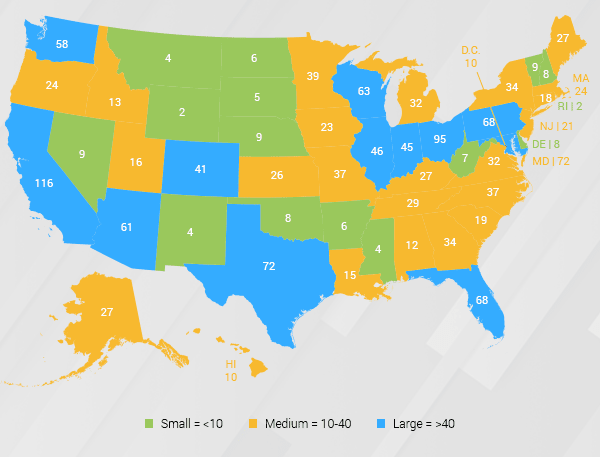
Figure 4. Dog-Friendly Events by State
Part II – A Furry History
A Rise in Dog-Friendly Events (3/4)
So, what does all this tell us about the state of dog-events today? And what is the history behind the changing trend? The perceived and now confirmed (through research) health benefits may be just one of many reasons why dog friendly events have become more popular in recent years. The rise may not have as much to do with catering toward dog owners, as it has to do with America’s penchant for more thrilling, creative and unique runs.
Whereas 20 years ago Color Runs, Glo Runs, and Obstacle Course racing were unheard of, today’s audience seems to be demanding something new and exciting. While the movement for dog inclusion in races has in many ways benefited from this penchant for new thrills, this is not always the case. Due to the increased demand for unique races, many long-standing dog runs have found their base drawn away by other family-friendly, creative events.
So, then, how have dog-friendly events continued to increase in perveance in spite of increased competition for participants and attention? The rise in dog-friendly events seems to coincide with America’s desire for inclusion and fun, as well as the goal of improving ones health. As stated by Chet, the race director for Fun Races, “We combine running with things we enjoy: Beer, Wine, Dogs, Kids, Obstacles.”
Another reason may be America’s obsession with health. As mentioned before, health remains a significant and well-known benefit of dog-ownership, and many organizations have embraced this for a myriad number of reasons.
The American Cancer Society places a huge emphasis on the dog-human bond, and the role canines play in both treatment and recovery from cancer. To recognize this amazing dog-human bond, they have “canine caregiver” designations and recognition in many of their walks and runs, and a series of more than 350 walks across the country called Bark for Life which celebrates the dogs who help patients survive cancer.
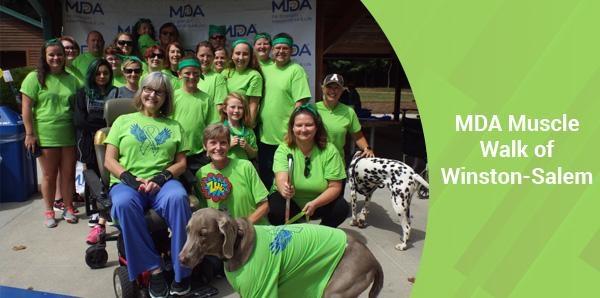
The Arthritis Foundation has likewise embraced dogs with open arms, with a designated “Wagger’s Welcome” logo (signifying that the walk or run is dog friendly), on almost all of the 86 Jingle Bell Runs, and over 46 Walk to Cure Arthritis Events. They note that, “Dogs get arthritis too!” and if dogs and their humans go out for a walk together, then both are benefitting. Their website specifically notes that “Pet owners are encouraged to bring their dogs,” and many have special perks for four-legged pals, such as the their Jingle Bell Run in Atlanta where a local vet hosts furry friends in the “Doggie Den” for special day before the big walk.
Along with the Arthritis foundation, other groups such as veterinary schools (e.g., The LSU School of Veterinary Medicine) are holding races and events which encourage participation for the sake of the dogs health. This comes in tangent with the emergence of professional dog runners who pet-owners are now hiring to ensure their pal gets more exercise than the average dog-walk will offer (e.g., Paws in Motion, “ Running With Dogs as a Full-Time Job,” “The Best Dog Runners in the Country”).
Runs such as the Metrowest K9 5K encourage dogs and their people to, “Stay Healthy Together,” a theme reinforced in an article from the American Animal Hospital Association entitled, “Walk Your Dog, Save Your Life.”
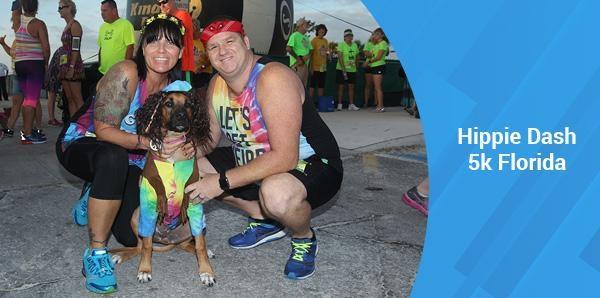
There are hiking clubs for dogs (e.g., Paws on the Path), Dog Scouts of America, and even Fitbit devices designed to monitor your dogs level of physical activity (Peppy Pets). SEAL Team PT has a dog-friendly workout for humans to do with dogs to prepare them for running events (SEAP Team PT).
Some races even offer information on how to train your dog for health. At the K9 Canter in Westminster, CO, they hold workshops which focus on assessing a dog's true fitness level and ways to improve their conditioning (e.g., "Did your dog slow you down? Did he race across the finish line...or walk?"). They claim that learning this information, “…can help prevent injuries and improve their [the dog’s] quality of life.”
Other organizations pair up dogs with kids for health benefits. The Richmond SPCA has a volunteer program called Running Buddies which helped boost kids’ self-esteem and help them feel confident exercising. The free program emphasizes that, “A dog will never critique your form or laugh at your running apparel,” and offers a range of runs and walks for kids, adults and seniors (as well as canines) of all fitness levels.
Bars are even holding informal pub runs for people and their 4-legged pals. In the words of founding partner Leib Dodell of Bar K Running Club, “We think these runs are a great recreational opportunity for people and dogs, they promote a healthy lifestyle for both, and they are a great bonding experience because the dog has fun while learning to follow and trust the person’s commands."
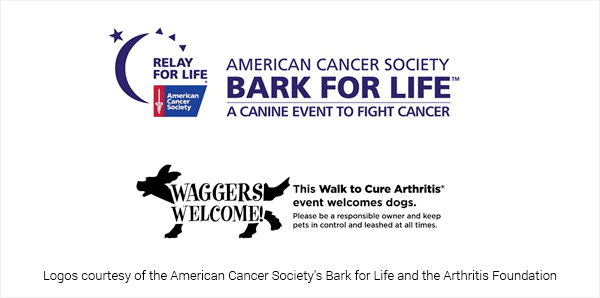
Many other organizations related to health, wellness and mental illness have also jumped on board. Although some events are unfortunately limited in their capacity to allow dogs other than service dogs due to the nature of the venue (e.g., a football stadium, or other publish place where dogs are prohibited), many non-profits and other organizations have nationwide events which are largely dog friendly. These include YMCA walks, Paws for Pink, the Linc Cancer Foundation, Heroes in Recovery, Run 4 Hope, Free to Breathe, the Walk to Defeat ALA, the AIDS walks, and walks by the MDA Society.
While not all health and wellness organizations tout dog-friendliness for their events, oftentimes they will still tolerate furry friends unless venues or other issues interfere. Out of Darkness already has over 160 walks planned for spring of 2018 (most of which are dog friendly), and while Free to Breathe, which has over 33 events this coming 2018 year, does not encourage dogs to come, they do allow it as long as rules are followed and the dogs are well behaved.
The Alzheimer’s Association, which hosts nationwide Walk to End Alzheimer’s events in over 600 communities each year, generally allows dogs as long as the location does not prohibit it.
Many race directors have also gotten in on the trend, committing to make as many of their events as dog-friendly as possible. These include All Out Multicourse Productions, the Kenosha Running Company, Pacers Running, Rainshadow Running, Tri to Finish, LLC, Trail Nerds, Tri Cycle and Run, Wanderlust, Aruna Project Runs and many of Dave’s Running events which are largely dog friendly.
And then there are the dog-organizations. Groups such as the Humane Society (by far the leader with over 80 of documented races in 2017), the SPCA, hundreds of dog and animal rescue organizations, Pup Run, Paws for a Cause and Virtual Run Events (Day of the Dog) all host nationwide events exclusively centered on dogs and their humans.
Strut Your Mutt which started as a fundraiser for local animal welfare groups in Salt Lake City in 1996, has grown to 14 live events and a "virtual" online event. Their participation has been growing each year, and in 2017, they reported over 13,000 participants across all their walks.
Risks and Benefits (5)
With the growing rise in dog races, however, come insurance and liability issues. Many race directors are either unaware of the insurance requirements and risks they take by allowing dogs to participate, or choose a blanket policy of no dogs at their events to avoid added costs and other problems. Some make a point of emphasizing to runners that under no circumstance will dogs be tolerated (which is actually quite useful as a number of runs with names which suggest dog friendliness in fact do not allow dog participation).
A run in Sanford, FL, for example, The Fast and The Furriest 5K Run/Walk, makes it very clear on their website, in red, bold font, “Human participants only please,” and many others detail policies of only allowing service animals for various reasons, ranging from insurance and liability, to venue limitations.
The Road Runners Club of America has also taken a very strong stance against dogs at runs, and their website states that, “The Road Runners Club of America strongly recommends that group run leaders and event organizers adopt a "no dogs/pets allowed" policy for anyone participating in group training runs or organized events . Furthermore, event organizers should have a "no dogs/pets allowed" policy for volunteers, spectators, and participants in the start and finish areas of an event. Only service dogs should be allowed at an event with a participant or spectator, and an event organizer may ask if a dog is a service animal. “
Race Director Tom Dosier of Go Time, Inc. points out the trip hazard created by leashes, specifically that when there are a large number of people moving very quickly on the road, it can be easy to miss a small dog, or become entangled in a leash at the starting line. He also notes that sorting out which pets have been properly trained, and are up to date on all shots and vaccinations, can be a logistical nightmare for directors, which is a significant issue in terms of the bite risk both for humans, and other dogs.
While Mr. Dosier notes that organizational insurance policies for non-profits (e.g., many dog and rescue groups which hold these dog-friendly events) often include event insurance for any event they may have during the duration of the policy, they do not always specify the allowance of pets.
On the other hand, more broad insurance policies held by most traditional race directors may or may not specify pets, which is why it is a common practice among race organizers to not specify if dogs are allowed or not, and then ask any participants who do show up with pets to start at the back of the group.
Despite these risks, many race directors feel strongly in the power of healing and change brought about by dogs, and seek to make sure they are included in their events. Lala Kozischek of the YMCA says she strongly believes that dogs should be allowed in runs. In her words, the “YMCA's typically take[s] a holistic approach to health and wellness and our mission includes mind, body and spirit for all. Pets are such a part of families that it's a no-brainer in my opinion.”

Mr. Dosier claims that he is, “….personally…pro pet involvement because I know the true value of a human/pet relationship in many of our lives,” and Susan Fujimoto of the Walk n’Roll for Animals 5k in Alaska states that, “One of the things we emphasize with the walk is the human-canine connection…,” and thus to hold the event without them would go against their cause.
Ben Holmes of Trail Nerds in Kansas feels the same way about trail runs for dogs. “Dogs and trails go together like bread and butter,” he says, noting that many trail runners train with their dogs. He acknowledges a difference, however, between trail and pavement runs.
In his own personal experience, he has found that, “The participants of paved races are a LOT different than trail racers; they have a tendency to complain a lot and have more of a sense of entitlement,” which is why he believes that trail runs tend to be more dog-friendly than road runs. He estimated that 95% of race directors of pavement races are “purists” and would not want dogs in their event (unless it was a race specifically for dogs), and that only 1/3 off-pavement would allow dogs.
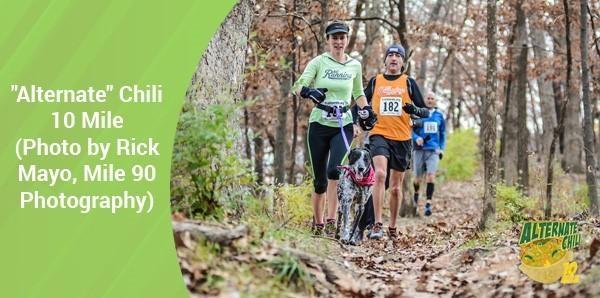
But, as always, when there is a will there is a way, and race directors have found creative solutions to make sure dogs and their humans are safe and have a barking good time at their events. Many hold dog-only events as part of their lineup, ensuring dog owners do not get their leashes tangled with more competitive runners.
Others ask dog-owners to line up at the back of the pack (so to speak), or put out restrictions such as disqualifying dog-running participants who finish faster than a certain time. For example, the race policy for Lola’s Lake Waconia Half Marathon states that, “Dogs must run a 12min/mile pace or slower, any Dogs that finish faster than the 12min/mile pace will be disqualified.”
The Cap City 10k also has taken a similar approach, and has separate corrals for dog owners, so while they still participate in the same race as everyone else, leashed dogs and their owners are asked to start in corrals C thru F.
The most responsible and passionate directors also make sure that insurance and liability issues are taken care of ahead of time. For instance, All Out Multi Sport, reported that they actually, “Pursued an insurance policy that would allow them [dogs] no matter what, to be sure this would remain a benefit for our athletes,” and Napa Humane’s Walk for Animals has an ambulance and EMT on site just in case.
Most importantly, many of the more established dog-friendly events and races go out of their way to make sure that dogs are safe too. In addition to warnings on website such as disqualifying runners who “drag” their dog across the finish line, many events, like the Spay Pride 5k held by Panacea Animal Wellness Sanctuary, The Doggie Dash in Boulder, CO, The Fast and the Furry Races 8K & 5K9 in St. Paul, MN, and Run Your Happy Tails Off in Dunwoody, GA, are staffed with vets who examine and approve dogs to run before the event and attend to any injuries as they arise (e.g., Doggie Bones 5k and 10k).
A large number also offer water bowls and dog treats at human water stations, and even doggie pools at the end of the race to help furry runners/walkers cool off. Spay Pride also offers a free Pet First Aid and CPR program hosted by local veterinarians to discuss how to make a first aid kit for your dog/cat along with pet CPR training.
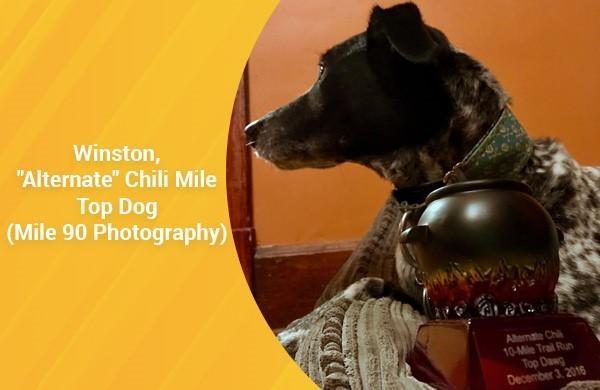
While most directors report very few incidents, across the whole, there have still been events where leashes got tangled, people fell and were injured, dogs got into fights, and in very few cases, people (and dogs) were bitten. However, per reports of over 1000 race directors specifically on the issue, these incidents are far and few between.
The majority of race directors interviewed voiced a common understanding among dog owners who attended these events, with most people only bringing very well-behaved pups who are good in public, and prepared to run, to events. In the words of Molly Moody, the Special Events Manager who oversees Strutt With Your Mutt, “Owners are pretty cognizant on if they should bring their dog or not based on how social it is or if it doesn't do well around other dogs.” She reported no incidents in her time as manager of the Strutt with Your Mutt event.
Why Allow Dogs? (6)

There are many reasons why race directors choose to allow dogs. While some have to do with the previously mentioned health benefits, others include dogs for personal reasons, or as an incentive to draw more people to their walks and runs.
Kaisha Johnson, affiliated with the Napa Walk/Ride to Defeat ALS, states that after working for years with an Animal Assisted Therapy Farm service people of all ages, she is, “…a strong believer in animal therapy and positive health implications.” Laura Lutrick, the Executive Director for the Mississippi & Western Tennessee MDA walks says that as an animal lover, she is a strong supporter of dogs in walks, having, “… witnessed the benefits that service dogs have on persons living with muscle disease.”
Even celebrities publicly discuss the important role dogs have played in their lives. An example is Julianne Hugh who posted a video of how her dog helped support her through her own medical trials and pain.
Race Directors for the 2018 Mutt Strut even run a pet therapy program at Furman University to help students relax during stressful periods. Julia Brunelle with the Greenville Humane Society who is a part of the program notes that they are strong, “…advocates for the positive effects animal interaction has on mental health.”
And, dogs help raise money. An app, Woof Trax, has even been developed through which people can help to raise money for dog shelters, and for many animal shelters, the Humane Society, SPCA and other animal rescue groups, these walks/runs are a huge source of revenue generation for their cause.
Team Paws Chicago has a “Shake Your Tail Couch to 5K” training program which helps first time and beginning runners raise money for homeless pets and get in shape, with the added benefit of a charity entry into the PAWS Chicago 5K Walk/Run in June 2018.
Finally, money and health aside, there are competitive runners out there who like to win, or at least perform at their best. Eric Morse (a USATF New England Grand Prix Champion, 2017 Run Vermont Hall of Fame Inductee, and winner of numerous USATF-NE individual races) and his terrier Murdock are a competitive running duo who have swept up wins, such as knocking down the Rolling Hills 5K Road Race record in VT with a course breaking time of 19:20:06. They often cruise along at a 5 to 6-minute mile pace!
Other famous runners report training with their dogs. Colt and his human (Chris Vargo, a 2014 U.S. 50-mile trail champion) train together in Flagstaff, AZ, and Emily Harrison, a 50K road champion and winner of several 50-mile races is outrun by her border collie Bee on most training days. Joelle Vaught (2nd place winner of the 2014 The North Face 100K Australia) also reported training for years with her German Shorthaired Pointer, Ben, who sometimes ran as much as 40 miles a day with her.
To these runners, every aspect of training is key, from nutrition, sleep and hydration, right down to their running partner. Runners are warned not to change their routine before a race (e.g., don’t try new food, shoes, or other methods) and if that routine includes a dog, many may feel lost out in their field without their running partner.
As noted above, for many professional trail runners, their dogs are their constant pacers and companions while training. In the words of Sue Foster, the owner and co-founder of The Iron Doggy, “…if you run all of the time with your dog then show up on race day without the dog, it can feel like a significant change.”
Fur and Fun (7)
Beyond all these reasons above, there may be yet another more salient reason why pet-owners are now flocking in droves to these dog-friendly events – SWAG (or stuff we all get). People are increasingly choosing races both for the atmosphere and the benefits the event provides, and in the case of dog races, there may be more perks for dogs than for humans!
Surprisingly (or perhaps not surprisingly, given the APPA predicted pet owners would spend over $69.36 billion dollars on their dogs in 2017 ) dog owners don’t seem to mind, and some of the largest events are quite the affair, rivaling even the chaos surrounding the Boston and New York Marathons.
Some events have begun chip-timing dogs, and awards and prizes abound - the perks are nothing short of amazing. The Salt Flat Endurance Run gives all registered 4-leggeded participants a race shirt and bandana, a race bib number, water and electrolytes at aid stations, and a finisher medal/buckle when they cross the finish line.
There is a Trail Nerd K9 division in Kansas, where all dogs in Trail Nerds races get a bib number and race medals for the events, and official race results for dogs (who have a separate doggy division) are posted online.
Even if the swag is minimal, most dog walks and races include a bandana with entry fee (which oftentimes is free!). Many also include elaborate goodie bags with dog bones, treats, balls, and of course, many finishing Fido’s receive a medal!
For participants in the Iowa Dog Jog, labeled a BYOD (Bring Your Own Dog) event, fundraising swag includes the chance to name a litter of puppies, leashes and water bowls, machine washable squeaky toys and a whole bunch of dog treats.
At the Slacker Half Marathon in Georgetown, CO, they give treats away to all dogs at the finish line and have 10 kiddie pools for the dogs to jump in at the finish, in addition to 1st, 2nd, 3rd, place awards for the dogs in each race.
And at the Dog Days of Summer in Seattle, in addition to many different contests (e.g., the Cutest Dog Contest, Puppy Parade, Dog & Human Costume Contest, Dog & Owner Look Alike Contest, Tail Wagging Contest, and Hound Pound), all registrations include a custom designed Dog Days of Summer 5K T-shirt (for humans) and a custom printed dog tag and bandana for pets.
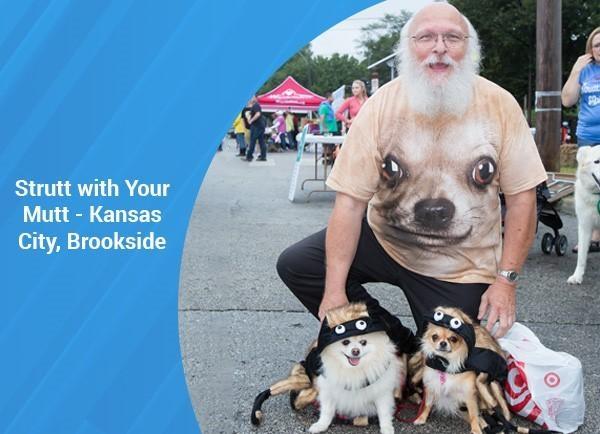
Some races determine awards for dogs based on weight classes, and offer incentives for dogs of all shapes and sizes to participate, such as awards for both the fastest and slowest dog. The Mighty Dog 5k in Folsom Lake, CA, has a Canicross Division which gives awards first through third place in the Small Dog (up to 25 lbs), Medium Dog (26 to 60 lbs), and Large Dog (61 lbs+), divisions), and others, such as Barktober Fest in Lowell, IN, determine divisions by other fun factors such as funniest, most original, and best owner and pet pair.
Many of the events also include festivals, and other dog-friendly events before and after the race, with dog cake-walks, dog contests (human and dog look alike, best licker, best kisser, best voice, best trick), dog and human yoga, dog massages, talks with an animal communicator, dog costume contests, doggie spas, doggie fashion shows, doggie splash zones, and bobbing for hot dogs (dogs only). Some even dole out custom frisbees, and canines in the Psychodelic 5K Trail Run in Kansas City, KS, receive their very own portable dog bowl.
Unique Types of Dog Races (8)
Perks aside, the races offered also stem from the traditional to the sublime! While traditional dog sports such as greyhound racing and dog-sled racing have been around for decades, sometimes centuries, these new races are more about fun for the casual dog owner who wants to see their furry friend perform.
There are races for dogs only, such as at Dog Fest and the Kentucky Dashound Derby, and walks which span two states such as the Canine March. Color Runs are no longer just for humans with the advent of dog color runs (e.g., Color Me Mutt), as well as Muddy Dog Challenges, and races to raise money for dog-specific issues such as canine cancer (5K Walk/Run for Canine Cancer).
Finally, for the competitive at heart, there are even Warrior Challenges such as the Badass Dash which has created a K9 Companion Division to allow you and your dog to tackle the obstacle course together.
Want something out of the ordinary? The Dawg Gone Canoe Race is an Alaskan fundraiser with up to 25 teams, each of which consist of 2 people, a dog, and a canoe. After a mass start teams jump into their boat and paddle down the Chena River stopping at 4 Checkpoints to pick up cards for a poker hand. More in the mood for snow? At the Twin Cities Snowshoe Shuffle, you can participate in the snowshoe event with a 5k for you and your dog.
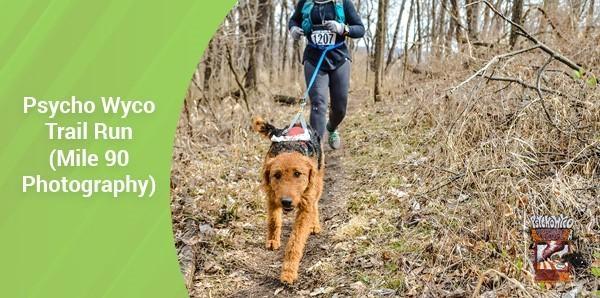
And if you are looking for a more leisurely event, at the San Diego Botanical Gardens, you can bring your dog on a 5k Paw Walk in the Garden. Burgers, Beer and Dogs 5k put on by Universal Sole in Chicago, IL, allows people to combine their love for their dogs and running with indulgent gustatory pleasures, and there is even a run for your Pug! The Great Pug Race of Lexington, KY, saw over 300 people walking or pushing their Pugs across the 5k course in 2017!
Finally, don’t forget races for humans who work with their dogs. The U.S. Canine Biathlon in Anniston, AL, put on by AMK9 allows both professional dog handlers such as police and military, as well as civilians, to compete in a challenge of obstacle racing with a 5K event featuring more than 20 purpose-built obstacles over varied terrain including forest, sand, and water. They expect over 1000 dog teams at the event in 2018.
Conclusion
So what does all this mean? Should everyone go out, rescue a dog, and begin exercising tomorrow? The research does seem to suggest that teaming up with a furry pal might not be a bad idea. Dog owners tend to engage in more physical activity (2, 5) which often leads to positive health outcomes (4).
Further, many of the race directors involved in dog-friendly races repeatedly reported story after story of how dogs had impacted the lives of those participating in their events, supporting individuals through challenging health struggles. This was especially true of events with a health-related component, such as those for the ALS, MDA, American Cancer Society, AIDS Walks and Arthritis Foundation.
As noted above, the events do not come without risk. If dog races continue to rise, race directors will need to become better aware of insurance and liability issues and take extra steps to protect both human and canine participants. However, many seem to have taken proactive measures in this area are more are climbing on board.
On the participant side, those wanting to engage in dog walks and runs need to be cognizant of their peers, clean up after their dogs, and keep everyone safe by following instructions and precautions given by race directors and vets. One should never push their dog through an event without properly training and building up their 4-legged friend (and themselves) for the race/walk ahead of time.
And if you do decide to run or walk with Fido, will you be able to find an event near you? Our findings, in general, say yes. The trends discovered through data analysis suggest that while some differences exist by region, overall, the number of dog-friendly events is more closely tied to the size of the population – with larger cities and metropolitan areas offering more opportunities for participation. Dog-friendly walks and runs tend to occur predominantly during the early spring and fall, so if you are eager to hit the trails with Fido, plan accordingly!
At the end of the day, lacing up your shoes and grabbing your pal’s leash to get outside may be only one of many ways to stay fit, but research suggests it is highly motivational and likely to stick (6) due to the social, mental and emotional benefits derived from both human and canine companionship (3).
In the words of Diane Geis, the Senior Community Development Manager for the North Region America Cancer Society, “…we have Bark For Life as we recognize the impact the dogs have on cancer survivors as they go through treatment.”
Attending a race will not only bring joy and wellbeing to your own life, it may help save many others (both human and animal), as well as earn you and your furry friend some awesome SWAG. And remember, while many races are BYOD (bring your own dog), you don’t have to have a 4-legged pal to participate as many offer dogs for the borrowing!
So what are you waiting for? “Animals are such agreeable friends,” said George Elliot, “They ask no questions, they pass no criticisms,” and what quality could be better than that in furry partner in crime?
Planet Fitness boasts a “No Judgment Zone,” for exercise, but dogs are judgment free 100% of the time. Put on some shoes, leash up a furry friend, and find an event near you! Whether you are up for a Color Run, Mud Run, Warrior Challenge, 5k, 100 miler, or just a stroll through the park, there are thousands of dog-friendly events across the country for you and Fido to enjoy!
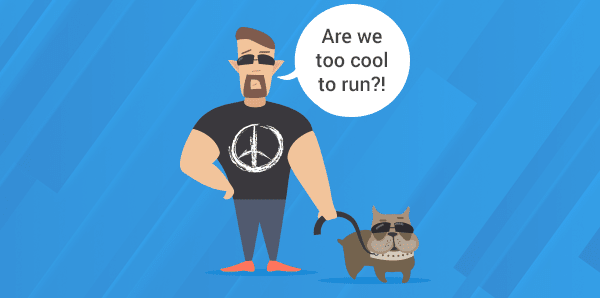
References
- Mubanga, M., Byberg, L., Nowak, C., Egenvall, A., Magnusson, P. K., Ingelsson, E., & Fall, T. (2017). Dog ownership and the risk of cardiovascular disease and death – a nationwide cohort study. Scientific Reports, 7(1). doi:10.1038/s41598-017-16118-6
- Christian, H. E., Westgarth, C., Bauman, A., Richards, E. A., Rhodes, R. E., Evenson, K. R., … Thorpe, R. J. (2013). Dog Ownership and Physical Activity: A Review of the Evidence. Journal of Physical Activity and Health, 10(5), 750-759. doi:10.1123/jpah.10.5.750
- Westgarth, C., Christley, R. M., & Christian, H. E. (2014). How might we increase physical activity through dog walking?: A comprehensive review of dog walking correlates. International Journal of Behavioral Nutrition and Physical Activity, 11(1), 83. doi:10.1186/1479-5868-11-83
- Garcia, D. O., Wertheim, B. C., Manson, J. E., Chlebowski, R. T., Volpe, S. L., Howard, B. V., ... & Thomson, C. A. (2015). Relationships between dog ownership and physical activity in postmenopausal women. Preventive medicine, 70, 33-38.
- Christian, H., Wood, L., Nathan, A., Kawachi, I., Houghton, S., Martin, K., & McCune, S. (2016). The association between dog walking, physical activity and owner’s perceptions of safety: cross-sectional evidence from the US and Australia. BMC public health, 16(1), 1010.
- Lim, C., & Rhodes, R. E. (2016). Sizing up physical activity: The relationships between dog characteristics, dog owners' motivations, and dog walking. Psychology of Sport and Exercise, 24, 65-71.
Appendix
Data Collections Procedures:
To gather the data and information needed for this paper, we pulled races from dog-friendly race lists posted by websites, bloggers and databases, including: Bring Fido, Iron Doggy, GetSet USA, Runners World, Start Line Racing, Run Ohio, Running USA, Palm Springs Marathon Runners, Tri To Finish, LLC, Phoenix Dog Magazine, Best Friends, ASPCA, HSUS, Aruna, Dog Fest, San Diego Pets Magazine, Total Body Fitness, Lung Cancer Foundation, SPCALA, Angel City Pitt Bulls, Conqur Endurance Group, Dave's Running (Toledo), Girls on the Run, Modern Dog Magazine, Arthritis Foundation, Unleashed Paws, CLE Dog, Dog Life in CLE, Dogs in the CLE, Welcoming Simplicity, Sidewalk Dog, PNWRunningcalendar.com, and Windy City Paws (Dog Friendly Race in Chicago). While this list is not comprehensive, it gives a general overview of the huge scope of material available.
We then set about contacting each race director individually to confirm whether or not the race listed was truly dog friendly (and still dog friendly), the number of years it had been held, if it was still being held, the type of race, restrictions, and any other information they were willing to offer. This gave us significant insight into the wide range of views race directors had on dog-events, and reasons for or against inclusion of dogs.
After confirming the aforementioned races, we began systematically using the internet to search for additional dog races in each state. We set a predetermined number of hours to work on each state, and an overall time goal. This was necessary as races are constantly changing and new ones being added and old ones removed. These searches included terms both for dogs: Dog, Fido, Rover, Furry, Fur, Paws, Puppy, Pet, Bark, Mutt, Canine, Doggie, Tail, Animal, Wag, Woof, K9, Pup, Stray, Friends, Bones, Pooch, and for races: Strut, Dash, Scurry, Walk, Run, Jog, Stroll, Step, Stroll, Race, Canicross, CaniXC, and trail.
Terms such as Family were also used as many events labeled as family friendly tend to allow dogs and strollers. These terms were chosen based on their high frequency of appearance in the races previously found in phase one of data collection from the lists of dog races online.
Data was retrospective including all races which were posted by the end of the 2017 year. After adding these races to the list, the same procedure used in phase one was employed, and each race was contacted directly (in repeated attempts over a 6-month period) to confirm dates and dog-friendliness, along with other important information.
Data collection occurred over a 6-month period of intense research devoted exclusively to data collection and revision. Data from traditional types of races such as sled dog racing or greyhound racing was not included. To be included an event needed to include a human-dog event in which the participants covered a distance together as a team.
One significant challenge was that the dog-friendliness of many events was tied to the location, and the person in charge of running the race - a walk or run may have been dog friendly one year, and not the next.
For that reason, and the extreme difficulty of collecting and contacting each director, in depth data analysis at this time was not possible. However, there was enough data and resources thanks to the generosity, time and assistance of thousands of race directors across the country to paint a comprehensive picture of the state of dog-friendly walk/run events in the US today.
Data Analyses
To further examine the more intricate nature of these races and explore general trends, the collected data was then assessed for outliers, and missing numbers. For the sake of this preliminary paper, races which were included on internet-databases, listed as dog-friendly races, or which had dog friendly logos or information connected with their website were included in the analyses, even if we were unable to reach the race director to confirm the races current dog-status.
Races were excluded if they did not allow dogs, but races where dogs could run in one of the events, but not all, were included (e.g., races with dog-friendly and no-dog waves, or races where dogs could only participate in the 5k, but not the marathon).
In addition to information on where the data was collection, races were categorized by Type (1 = Run/Walk, 2 = Trail, 3 = Canicross, 4 = Other), State, City, Date Run, Distance (e.g., <5k, 5k, 10k, ½ marathon, marathon, >marathon, other), race setting (1 = Allows Dogs, 2 = Race/Walk for Dogs, 3 = Dog Walk Only, 4 = Virtual Dog Walk/Run Only), chip timing for dogs, number of years run, and whether or not it was part of a larger organization or group of runs (e.g., Bark for Life, Paws for a Cause, Jungle Bell Run).
Information was also collected on dog perks (e.g., prizes, awards, medals, swag bags), and course amenities (e.g., hydrating stations with water bowls and dog treats, dog pools at the end, vet exams, etc.). Categories for which too little data was available for analyses were excluded from results.
Acknowledgements
The author would like the thank the thousands of race directors, animal shelter volunteers, and other amazing people who devoted their time and efforts to help make this research paper a possibility. Prior to this paper, there was no comprehensive study or event research database from which to use as a basis for this undertaking. Input from each and every race director contacted was a vital piece to the puzzle, and helped build from scratch a basis for all future work to come.
In writing this paper, I came in contact with the kindest, generous, and most passionate dog lovers. I cannot thank you enough for all the time and care you took in helping me to collect data, research the history of your races, and help document dates, times and events. This paper is dedicated to all the passionate dog-lovers and courageous race directors who work tirelessly to save and change thousands of lives through their involvement in dog-events across the county.
